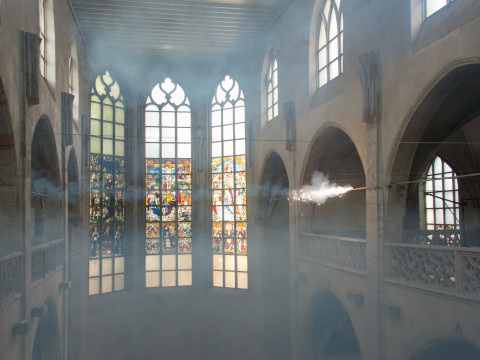Concept, direction, space: Lea Letzel
Composition: Maximilian Maintz
Musical direction: Uwe Dierksen
Dramaturgy: Christian Grammel
Technical advice: Fabian Offert, Bjoern Mehlig
Ensemble of the International Ensemble Modern Academy: Matthew Conley, trumpet/ Eva Boesch, violoncello/Vincent Hepp, violin/Vincent Manuel Minguet-Soria, saxophone/ Francisco José Naranjo Reyes, oboe/ Arlette Probst, bassoon/ Alberto Carnevale Ricci, piano/Deepa Goonetilleke, horn/Delphine Roche, flute/ Marie Schmit, violoncello/ Anna voor de Wind, clarinet/Rho-Mei Yu, percussion
Sound direction: Sarah Hölscher
A cooperation of the Institute for Applied Theater Studies Giessen, the International Ensemble Modern Academy, the Frankfurt LAB and the ZKM | Center for Art and Media Karlsruhe
With the kind support of the Institute for Applied Theater Studies of the Justus Liebig University Giessen, HTA, STEAM -Tonstudio of the Hanns Eisler Academy of Music, satis&fy,basis Frankfurt and the Forestry Office Giessen
The IEMA grants are supported by the Kulturstiftung des Bundes, the Kulturfonds Frankfurt RheinMain and the Kunststiftung NRW for artists from North Rhine-Westphalia.
"What is the use of composing if the work is confined to the narrow confines of the concert or the solitude of the radio receiver? To compose is, at least in tendency, to give to do; not to hear, but to give it scene, on which the musicians pass back and forth from one source of sound to another in often brilliant playing. We still play as delegates; it is conceivable, however, that the concert - later? - will be exclusively a workshop, which would not, no dream, no imaginarium, in short, no "soul" would let itself be exuded and where all musical doing would have merged into a practice without rest. To formulate this utopia, a certain Beethoven teaches us, who is not played - that is why in him a musician of the future can be suspected."
Roland Barthes - musica practica
In Western culture, music is primarily transmitted through writing: Points, lines, and waves encode the interplay and temporal progression of sounds in a complex system on a flat surface. Height, duration and volume are graphically represented and fixed.
In the digital age, sounds are graphically represented in the so-called waveform for their processing. It tells the story of a sound from its creation to its fading away. I never went south/ a concert is based on the visual analogy of these waveforms - as they are used in the graphic representation of sounds - and the natural shape of conifers.
The waveform as a digital surface for sound processing shows up as a sequence of conifers strung together. The starting point for this equation was ultimately the possibilities and visualizations of digital audio technology. Sound is no longer a purely acoustic phenomenon, but since the beginning of digitalization has experienced a number of other "notations" in addition to the classical note form.
The representation as a waveform traces a sound from its creation to its fading away. The level, i.e. the volume, characterizes the visual imprint of a tone.
The musical tone differs from a non-musical sound because every musical tone consists of a sound wave whose form is repeated many times. The sound, therefore, the basis of music, which is "mechanical oscillations and waves of an elastic medium in the frequency range of human hearing (16-20 000)Hz). The frequency, i.e. the speed of the vibration is decisive for the pitch, the amplitude determines the volume of a tone.
The notation system of I never went south/ ein Konzert is thus based on the visual analogy of these waveforms, as used in the graphic representation of sounds, and the natural shape of coniferous trees. Thus, if one were to feed the image of a coniferous tree into a computer's sound processing program and then claim that this tree was the image of a sound, the sound supply of the composition to be worked out would be generated from the available tree outlines.
The light control in the first four parts, sequences 1-4, was based on four different coupling principles associated with the trees.
How we perceive the landscape that surrounds us is shaped by ideas of itself. Understanding landscape as a system of order - and derived from it as a musical system of notation - is the basis of I never went south/ a concert. The meanings of the elements of nature are reinterpreted in favor of an intentional composition. Our interaction with nature is structured as a system of different degrees of order.
"People in rank and file; plants in rank and file. Nature orders differently and variously, but never as man does, mostly for economic reasons: nature never orders in rank and file" Louis G. Roy : On the Degradation of Soils. About the stinging nettle
The forest manifests itself in its chaos as a contrast to cultivated nature, the strictly laid out baroque garden, for example. Analogously, music can be understood as structured time, which creates a boundary, or a transition to the world of noises and everyday sounds through different degrees of organization. The creation of a spatial system of notation, in contrast to the classical score, makes notation and composition simultaneously perceptible to an audience. The border areas of music thus also become perceptible as a material, as an architectural border.
I never went south/ a concert was awarded with a nomination for the Bühnenbildpreis Offenbacher Löwe 2012.
Preview on 31.08.2011 FrankfurtLAB
Premiere on 30.09.2011 at the medientheater of the ZKM | Center for Art and Media, Karlsruhe








